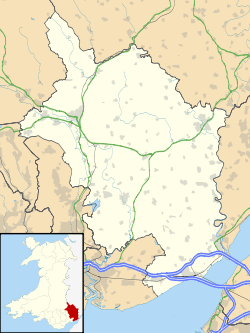Lower Hael Wood
| Site of Special Scientific Interest | |
|
View of the wood from the English side of River Wye | |
 Location within Monmouthshire | |
| Area of Search | Monmouthshire |
|---|---|
| Grid reference | SO533075 |
| Coordinates | 51°45′51″N 2°40′49″W / 51.7643°N 2.6802°WCoordinates: 51°45′51″N 2°40′49″W / 51.7643°N 2.6802°W |
| Interest | Biological |
| Area | 17.6 hectares (0.176 km2; 0.0680 sq mi) |
| Notification | 1981 |
Lower Hael Wood is a semi-ancient woodland and Site of Special Scientific Interest (SSSI), noted for its biological characteristics, in Monmouthshire, south east Wales.[1] It is part of the wider Hael Woods complex. The wood is on the side of the River Wye which is the border between Wales and England.
History
There is evidence of early human activity on the woodland site, with Bronze Age barrows having been found.[2] Early industry was also present on the site, with a grist mill on the southern slope and evidence of quarries also found.[3]
Geography
The 17.6-hectare (43-acre) SSSI, notified in 1981, is located within the community of Trellech United, on the banks of the River Wye, 3.5 miles (5.6 km) south-east of the town of Monmouth. It is 0.5 miles (0.80 km) south of another SSSI, Graig Wood.[4][5]
The wood is owned and managed by the Forestry Commission.[6] The Wye Valley Walk which is a long distance footpath, runs along the edge of the woodland,[5] the River Wye and the border with England.
Wildlife and ecology
As with other woodland in the Wye Valley Area of Outstanding Natural Beauty, Lower Hael Wood contains many local and rare tree species. The main tree species found on the site include ash (Fraxinus excelsior), common beech (Fagus sylvatica), small-leaved lime (Tilia cordata) and wych elm (Ulmus glabra), as well as English oak (Quercus robur) and sessile oak (Quercus petraea).[1]
Several insect, bird and other animals have been recorded on the site. Birds include Eurasian sparrowhawks, common sandpipers, long-tailed tits, red-legged partridges, Eurasian skylarks, mallards, greater white-fronted geese and meadow and tree pipits. However the only amphibian found is the common frog.[7]
References
- 1 2 "Lower Hael Wood" (pdf). Countryside Council for Wales. Retrieved 31 May 2012.
- ↑ "Archaeological Heritage". Wye Valley Area of Outstanding Natural Beauty. Retrieved 1 June 2012.
- ↑ "Lower Wye Valley: Hael Woods". Glamorgan-Gwent Archaeological Trust. Retrieved 1 June 2012.
- ↑ "Lower Hael Wood map" (pdf). Countryside Council for Wales. Retrieved 31 May 2012.
- 1 2 Ordnance Survey: Explorer map sheet OL14 Wye Valley & Forest of Dean ISBN 9780319240953
- ↑ "Lower Hael Wood". Countryside Council for Wales. Retrieved 31 May 2012.
- ↑ "Species records at 10km or better that fall within or overlap Lower Hael Wood (SSSI)". National Biodiversity Network. Retrieved 1 June 2012.
